A CalFresh start
November 19, 2010
It was a long time ago, but when Bob McKinnon traces the successful trajectory of his life—his Madison Avenue advertising career, the creation of his own boutique firm—he thinks about food stamps.
He remembers how they helped him eat better so he could study harder. His mom, a single mother of three, had been diagnosed with cervical cancer and needed help from the government to steady her family during the rough patches.
But McKinnon also remembers the way some people denigrated that helping hand, calling it a handout “for people who are lazy or aren’t trying.” And, in that regard, not much has changed over the years. The stigma lingers. Only now, McKinnon, 41, is in the forefront of a movement in California to do something about it.
McKinnon, the founder of a public-spirited communications and advocacy firm in New York, was enlisted to help California rebrand its food stamp program in the hopes of undoing decades of negative stereotypes and encouraging eligible participants to step forward and sign up.
In October, California’s food stamp program officially became known as “CalFresh: Better Food for Better Living.” The name—and accompanying logo—followed months of consumer research, strategy sessions, stakeholder meetings and focus groups from Merced to San Bernardino, comprised of low-income Californians receiving assistance or eligible for it.
“Looking back, to think that at some point my mom had to feel badly for even a second to help us, bothers me to do this to this day,” says McKinnon, whose company, YellowBrickRoad, specializes in “advocacy communications” on issues ranging from childhood obesity to climate change. “Do critics of these programs really think people don’t want to feel pride?”
The rebranding process began two years ago, when the U.S. Department of Agriculture changed the name of the food stamp program to the Supplemental Nutrition Assistance Program, or SNAP. The change was made to reflect the reality that food stamps and scrip were abandoned years ago in favor of electronic debit cards. The federal government told the states they could adopt the same name for their programs or come up with new ones.
California seized the challenge like no other—for good reason.
The state’s 3 million food assistance recipients represent just half of those eligible for the benefits. Only Wyoming has a worse record. As a result, California has been missing out on an estimated $4.9 billion in federal nutrition assistance that would flow through the state’s ailing economy. The program pays a monthly benefit of $200 for an individual and $526 for a household of three.
The California legislature, with a strong push from Oakland-based California Food Policy Advocates, passed a bill in 2008 by Assemblyman Jim Beall, Jr. that not only called for the creation of a new name but also lifted asset restrictions that effectively required some applicants to exhaust virtually their entire net worth to qualify.
“One of the things we wanted be clear about is that we didn’t want to put a new name on an old program,” says George Manalo-LeClair, senior director of legislation for CFPA, which assured lawmakers that no public money would be spent on the process. “We recognized that this was not the No. 1 priority for the state.”
To research and test potential names for the state’s Department of Social Services, The California Endowment stepped in with a grant of $150,000, enough to cover some of the costs of YellowBrickRoad and Lake Research Partners, which conducted the focus groups.
Manalo-LeClair says his group and others were determined to come up with a name that would resonate positively with potential participants, many of whom have been hit hard by the economy but could not see themselves applying for food stamps. The idea was to create branding that stressed the nutritional, rather than the welfare, aspects of the program.
California officials, Manalo-LeClair says, didn’t want to follow the path of the federal government, which “took words that the House liked and that the Senate liked and squished them together.” The result, he says, was a name that focus groups agreed conjured up images of a welfare program with “long lines and hassles.”
It was during these sessions, as interviewers asked participants to offer words that suggested healthy eating, that “fresh” first surfaced. Many involved in the process liked that it worked on two levels—fresh, as in fresh food, and fresh, as in “you’ve hit rock bottom and need a fresh start,” as McKinnon put it.
Some within the bureaucracy, however, weren’t nearly as thrilled when presented with the proposed CalFresh name. They thought it was vague and confusing. Without the tag line, it didn’t even allude to the program’s key aspirations—to provide food and help. How would people know even to apply?
“When you’re dealing with government stakeholders, they want to come up with a lot of acronyms,” McKinnon responds. “But you’ve got to ask: Who is our audience? We need to make sure that the name appeals to them first. To us, a little bit of abstraction was perfectly acceptable so people could see themselves in the program.”
But the criticisms from the insiders, who were concerned about the program’s success, were mild compared to those that came after California’s first lady Maria Shriver unveiled the rebranding during a media event in Long Beach. Conservative radio hosts and bloggers feasted on the change.
Typical among them was this from self-proclaimed “Advice Goddess” blogger Amy Alkon, the author of a recent book bemoaning the lack of civility in American life : “Sorry, but there should be a stigma against using food stamps…My parents raised us to think it was shameful not to support yourself.”
Food advocates in and out of government seethe when they hear intentionally provocative off-the-cuff takes like these, which misrepresent the demographics of those receiving help and the impact of the nation’s economic meltdown on working families. The fact is that children represent roughly half of the recipients.
“Someone with an opinion like that might lose their job tomorrow and then need food assistance themselves,” says Judith Lilliard, who oversees the food stamp program for Los Angeles County’s Department of Public Social Services. “We’re trying to build a healthy society here. We don’t want people starving in the streets because they’re embarrassed to apply for food stamps.”
To that end, Lilliard’s department has been a leader in streamlining the application process, allowing people to sign-up by mail, phone and, soon, through the Internet. The county also recently began a mobile service, dispatching a computer-outfitted truck into neighborhoods with high numbers of eligible participants.
Underlying all these efforts, Lilliard says, is recognition by the county that many of the working poor will not enter a government building to apply for food assistance because they feel it’s humiliating.
Lilliard, like McKinnon, knows something about that feeling.
In the mid-1960s, she grew up in housing projects in East L.A. and low-rent apartments in South-Central. She remembers tagging along with her mom to pick up the family’s food stamps, which back then were distributed by banks. The recipients were told to line up outside at a walk-up teller.
“I remember thinking, “This is not right. Why are we out here when they have a perfectly good building,’ ” Lilliard says. “The bank felt that people getting food stamps weren’t good enough to go inside the building.”
Lilliard says that, over the years, she’s held a variety of positions within her department’s general relief and food stamp division. (“We’ll be renaming that soon, by the way.”) But it was her pre-teen years that Lilliard says have given her a special qualification for her job as division chief—empathy.
“I’m good at being able to put myself in someone else’s shoes,” she says, “because I’ve been there myself.”
Before you tuck into turkey, read this
November 18, 2010
Jean Tremaine would like to interrupt the coming feeding frenzy with a public service announcement:
Thanksgiving dinner is a meal, “not an all-you-can-eat buffet that starts in the morning and goes through the weekend.”
Not that Tremaine, director of the county’s public health nutrition program, wants to be a turkey day buzz-kill.
By all means, she says, enjoy those once-a-year specialties. (Especially if depriving yourself at dinner means you’ll make up for it with a chocolate binge at home later.)
But come in with a game plan. Eating strategically is more than just a way to strike a blow for eating sanity at a meal that can easily weigh in at 3,000 calories or more.
It’s also a chance to create a healthy eating pattern for all of the holiday temptations ahead.
“Heading into the overeating season, it’s a good opportunity to set the tone and come out of this relatively unscathed,” says Tremaine, a 23-year county veteran whose department oversees nutritional education programs, helping to translate healthy eating practices into individualized approaches for L.A.’s ethnically diverse communities.
Otherwise, if you don’t watch it, “you’re in a food coma for the months of December and January.”
To stay out of that state—and to do your part to combat America’s obesity epidemic—here are a few of Tremaine’s tips for navigating the Thanksgiving bounty.
1. Know your must-have dish, and then take it easy on the rest.
“The most important thing to me is the pumpkin pie. My sister makes it. It’s just the classic recipe off the can, with a little more spices.”
2. Concentrate on the people around the table.
“Enjoy the socializing and not focus so much on the food. It’s called thanks giving. Think about what’s good in your life.”
3. Divide and conquer your dinner plate.
Load half your plate with vegetables (preferably not the kind that come doused in canned soup and topped with fried onions.) Leave one-quarter of the plate for turkey (no skin, please) and the rest for a starch of your choice. “Because there are so many simple carbohydrates, I skip some of them. I don’t need stuffing and mashed potatoes and a roll.”
4. Make the pre-dinner nibbles healthy.
“Normally, a Thanksgiving dinner starts hours before dinner.” Instead of “high fat dip, pretzels and peanuts,” offer guests seasonal fruit like sliced Fuyu persimmons, or a bowl of Satsuma tangerines.
5. Take it easy on the alcoholic beverages.
“Limit the booze. It’s high in calories and it lowers your eating inhibitions.” If you do imbibe, alternate your drinks with glasses of water.
None of this should make you think that Tremaine is some kind of joyless anti-food crusader. On the contrary, she’s the kind of person who enjoys seafood-eating vacations in places like Sicily or Sardinia. But, as a longtime Weight Watcher, she has learned how to combat a holiday tradition of “eat until you hurt.”
“A couple of decades ago, I stopped doing that,” says Tremaine, 63. “It’s a wonderful feeling not to eat until you hurt.”
And she thinks a less gluttonous approach can help people find more meaning in the holiday along the way.
“It’s really an occasion for reflection,” she says, “to ask ‘What am I grateful for?’ ”
For some other helpful hints, check out this turkey-carving video and make sure you’re up to speed on how to cook and serve your feast safely.
Posted 11/18/10
Finally, it’s in the (reusable) bag
November 16, 2010
Hoping to create a domino effect across the region, the Los Angeles County Board of Supervisors on Tuesday voted to ban plastic grocery bags, long considered an environmental menace and aesthetic blight.
The ordinance, which would take full effect next July, would outlaw the ubiquitous single-use bags only in stores in the county’s unincorporated areas, home to 1.1 million people. But the board majority made clear that the larger goal is to get the county’s 88 separate cities to adopt the same law.
Ultimately, the board hopes that the movement’s momentum will carry to Sacramento, where a nearly identical measure was recently defeated in the state senate after industry opponents to the ban spent more than $2 million on lobbying in the weeks before the highly-anticipated vote. Supervisors argued that a statewide measure would bring conformity to a potential patchwork of municipal laws that could confuse customers and businesses alike.
“When we pass an ordinance of this type, the rest of the state has to take notice,” said Supervisor Zev Yaroslavsky, a leading proponent of the ban, who called the bags “urban tumbleweeds.”
Should a groundswell not materialize, Yaroslavsky said, “we can do a lot here because we are 10 ½ million people….Even if nobody else does a single solitary thing, we can make a difference.”
Added Board Chairman Gloria Molina: “This is a major undertaking for L.A. County and I’m proud. The wave is beginning here…”
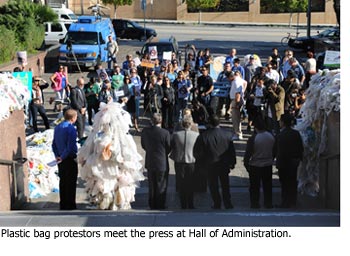 The measure was approved by a 3-1 vote. Supervisors Yaroslavsky, Molina and Mark Ridley-Thomas supported the ban, while Supervisor Michael D. Antonovich voted against it. Supervisor Don Knabe was not present.
The measure was approved by a 3-1 vote. Supervisors Yaroslavsky, Molina and Mark Ridley-Thomas supported the ban, while Supervisor Michael D. Antonovich voted against it. Supervisor Don Knabe was not present.
In Los Angeles County alone, more than 6 billion plastic bags are used each year, with only about 5% of them being recycled. Although the bags may feel flimsy, they are molecularly almost indestructible, surviving hundreds of years without degrading. Meanwhile, they litter the streets, clog landfills and flow into the ocean, endangering marine life and the commerce of the coastline.
The board’s action, which comes after several years of failed voluntary efforts, is certain to be welcomed by the growing numbers of environmentally conscious shoppers who’ve already started toting reusable bags to the market or who’ve been opting for paper, which is biodegradable. But a good number of consumers no doubt will not immediately embrace the mandated changes in their shopping habits.
The new county law not only bans single-use plastic bags, it also specifies what sort of bags can be provided in their place. Stores would have the option of giving their customers either paper bags—for which they must charge 10-cents apiece—or reusable bags. The intent of the 10-cent charge is to push consumers towards the reusable bags, the most environmentally-friendly option.
On Tuesday, the board approved an amending motion that broadened the ordinance’s definition of what constitutes a “reusable bag.” As originally written, the law would have required that the bags meet various tests for strength and durability, and that they be machine-washable. Under the amended version, the bags also could be made of materials that can be wiped clean or disinfected by hand. These standards are designed to prevent retailers from offering consumers new kinds of plastic bags that are also bad for the environment.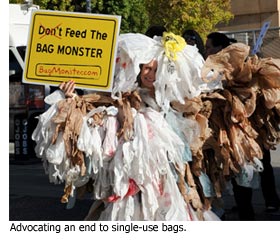
The board approved a second amendment specifically stating that reusable bags must comply with state and federal restrictions on permissible levels of lead and other metals, including cadmium. That 11th-hour addition came in the wake of recent reports that some reusable bags have contained high-levels of lead, leading U.S. Sen. Charles Schumer (D-N.Y.) this week to ask federal regulators to investigate the issue.
The board also directed that plastic carryout bags be phased out by next July at all county-operated facilities and offices.
In anticipation of the widely publicized vote, the board’s usually quiet meeting room was filled on Tuesday with boisterous supporters and opponents of the measure. The same lobbying organization that helped undo the Sacramento legislation—the American Chemistry Council—had recently shifted its forces to the battle of the bags in L.A., advancing the argument that the ban would kill small manufacturing businesses and leave hundreds of employees without jobs.
That theme was sounded by numerous speakers who briefly testified before the board, including one elderly woman who complained that there was “a lot of focus on plastic bags instead of people.”
Yaroslavsky said he was sympathetic to those concerns but noted that the continued fouling of the ocean could jeopardize the coastal economy and potentially lead to significant job losses.
“So at the end of the day,” he said, “we do what we think is right. And what’s right is to be part of the solution, not part of the pollution.”
Posted 11/16/10
Remembering Our Vets in concert
November 12, 2010
On Saturday, November 13, the Culver City Symphony Orchestra presents a special “Veterans Day Remembrance Day” concert, fittingly performed in the orchestra’s home venue of the Culver City Veteran’s Memorial Auditorium. The program includes a medley of themes for the United States Armed Forces, as well as Beethoven’s Symphony No. 3, “Eroica” and selections by Stravinsky and Schumann. Click here for further details.
Posted 11/12/10
Randy Newman revue opens at the Taper
November 12, 2010
The music of Oscar-winning composer and songwriter Randy Newman anchors “Harps and Angels,” a new stage production at the Music Center’s Mark Taper Forum, also premiering this week. Titled after Newman’s recent album – his first new collection of songs after more than a decade of prolific soundtrack work – the show offers a seasoned ensemble of performers the opportunity to dip into Newman’s vast catalogue of songs from the last five decades. Included are popular hits like “I Love LA” and “Short People,” as well as many lesser-known gems that are by turns wry, bitter and poignant. For tickets and information, see the Music Center’s website here.
Posted 11/12/10
An Island of Brilliance in Venice
November 12, 2010
The Co-Op at Pacific Resident Theatre in Venice this week opens the West Coast premiere of “Island of Brilliance,” a new play by Dawn O’Leary set to run through December 5. For reservations call (323) 460-2508. PRT, which this year celebrates its 25th anniversary of award-winning presentation, is located at 707 Venice Blvd. (4 blks west of Lincoln) in Venice. Visit their website for more information.
Posted 11/12/10
Battle of the bags redux
November 12, 2010
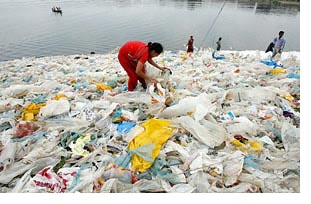 The Board of Supervisors on Tuesday is poised to enact one of the most far-reaching measures in the state to end the environmentally damaging proliferation of single-use plastic bags.
The Board of Supervisors on Tuesday is poised to enact one of the most far-reaching measures in the state to end the environmentally damaging proliferation of single-use plastic bags.
The highly-charged issue is being tackled by the board following the controversial rejection by the state legislature last summer of a ban on plastic bags. That vote came amid a furious multi-million dollar lobbying effort led by the American Chemistry Council, which represents industry players opposed to the measure.
The council has now turned its sights on L.A. County, sending out mass e-mails and using its Stop the Bag Police website to accuse the board of potentially undermining the economy and putting people out of work.
Environmentalists argue that the bags endanger wildlife, foul the beaches and ocean, and cost taxpayers millions annually to clean up. What’s more, they’re virtually indestructible, meaning the sacks can survive in the solid-waste stream for hundreds of years. Among the environmental groups that have written in support of the county’s efforts to ban the bags is Heal the Bay.
In January 2008, the board, led by Supervisor Zev Yaroslavsky, directed county departments to undertake an environmental analysis and develop draft legislation to ban the bags if a voluntary program failed to substantially reduce plastic sack consumption and promote more eco-friendly alternatives.
With the failure of the County program to achieve the targeted waste reductions mandated by the Board’s action, the tougher measures were pursued.
As outlined in a Board letter, Public Works’ preferred alternative would be to phase in a complete ban on plastic carryout bags in most stores in the county’s unincorporated areas, where the supervisors have direct jurisdiction. At the same time, a surcharge would be imposed on paper sacks to minimize a shift from one set of destructive environmental impacts to another. The goal is to get consumers to opt for the most cost-effective and environmentally friendly alternative—reusable bags.
Beyond banning the bags within its own jurisdiction, the county plan also calls upon its 88 incorporated cities to follow suit and adopt compatible programs at the local level to create a seamless countywide system that would serve as a model throughout the state.
For full details on the County proposal see the Final EIR part 1, and read the comments and responses in the Final EIR part 2. And for a deeper look at the political background of the controversy and its environmental implications, click here for an earlier account of the bag battle on Yaroslavsky’s website.
Posted 11/12/10
How’d your L.A. County district vote?
November 11, 2010
Although the rest of the nation may see us as one big, blue blob when it comes to elections, we are a diverse lot, we tribes of L.A. County.
True, voters here did more or less favor the Democratic candidates at the top of the ballot. But preliminary tallies supplied by the County Registrar-Recorder/County Clerk indicate that we begged to differ when it came to the propositions.
For example, only the Third District cast a majority of its ballots for the defeated Prop. 19, which would have legalized marijuana.
Although the last of the provisional and vote-by-mail ballots are being counted, here’s what we know now (see below) about how nearly 2 million ballots were cast in each of the five L.A. County supervisorial districts, ranging from the urban core, to seaside enclaves, to the high desert.
For a continuing look at the vote and results for a wide array of contests, click here.
Posted 11/11/10
Making a move on homeless at the Bowl
November 11, 2010
 Living in the hillside houses and condos above the Hollywood Bowl has long offered a taste of the rustic in the midst of the bustling city. For years, it’s also brought with it a stark urban reality: sharing the neighborhood with an encampment of homeless people.
Living in the hillside houses and condos above the Hollywood Bowl has long offered a taste of the rustic in the midst of the bustling city. For years, it’s also brought with it a stark urban reality: sharing the neighborhood with an encampment of homeless people.
Residents had long complained about crime problems and fire hazards associated with the impoverished community. “I know one of them came and jumped in our hot tub once,” said condo-dweller Jerry Shandy.
The Sheriff’s Department, which last year assumed policing responsibilities from county’s the Office of Public Safety, recently had its Parks Bureau set up shop at the county-owned Bowl, with a mandate to resolve the situation in a way that would help the homeowners as well as the homeless.
Sheriff’s Capt. Stephen Smith called in the department’s special problems team, which confronts crime and quality of life concerns in and around county parks. In addition to figuring out the logistics of shutting down the camp, the team created a plan to provide food, clothing and offers of shelter for the displaced.
 Deputy Jason Elkins, a 10-year sheriff’s veteran, twice walked the hillside and notified the homeless that, in the coming weeks, the area would be cleared. The Mountains Recreation and Conservation Authority, which manages the public land where the homeless had taken up residence, was brought on board, along with the county Department of Mental Health, Caltrans, the CHP, the Los Angeles City Fire Department and the nonprofit organization PATH (People Assisting the Homeless), among others.
Deputy Jason Elkins, a 10-year sheriff’s veteran, twice walked the hillside and notified the homeless that, in the coming weeks, the area would be cleared. The Mountains Recreation and Conservation Authority, which manages the public land where the homeless had taken up residence, was brought on board, along with the county Department of Mental Health, Caltrans, the CHP, the Los Angeles City Fire Department and the nonprofit organization PATH (People Assisting the Homeless), among others.
The effort was given a name that stressed its mission: “Hollywood Bowl Homeless Outreach Project”
“We didn’t want to leave anyone displaced,” Elkins said.
The operation began on October 27, with the team making its way up hillsides so steep that the homeless had created rope pulls to make the climb easier. Authorities had expected to encounter 30 homeless people but found that many, including one who’d been there for a decade, had left as a likely result of the notifications.
 Of the 14 who remained, ten accepted emergency shelter and the others voluntarily left, sheriff’s officials said.
Of the 14 who remained, ten accepted emergency shelter and the others voluntarily left, sheriff’s officials said.
Caltrans workers filled four trucks with the remains of the dismantled campsites. Follow-up work to remove overgrown vegetation took place Wednesday.
“From our perspective, unfortunately, we have to deal with these kinds of things quite a bit,” said Dash Stolarz of the Mountains Recreation and Conservation Authority, which now is working to restore the property and prevent new encampments. “It’s just a constant battle to make sure the parklands are safe.”
On Tuesday, Elkins and another team member, Deputy Nisha Sehdev, went back through the neighborhood Tuesday, talking to appreciative residents about the operation. One of them, Jack Calnan, spoke for the many when he said, “We really appreciate you being on top of it.”




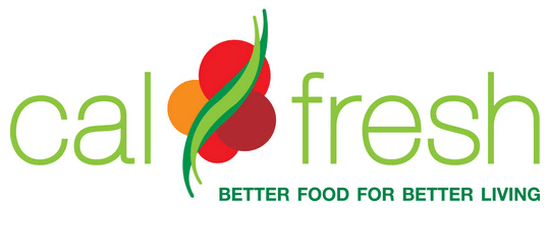


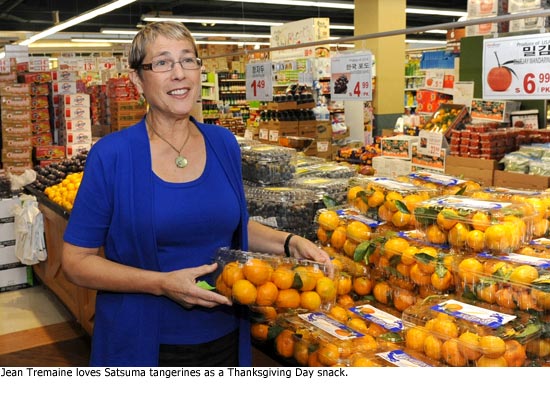
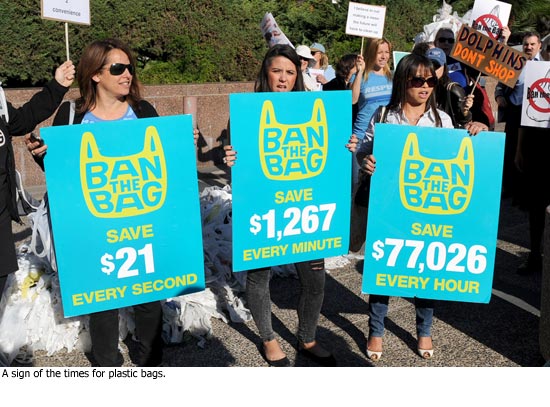
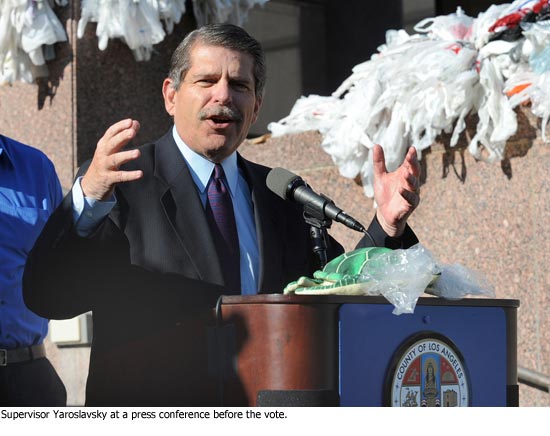
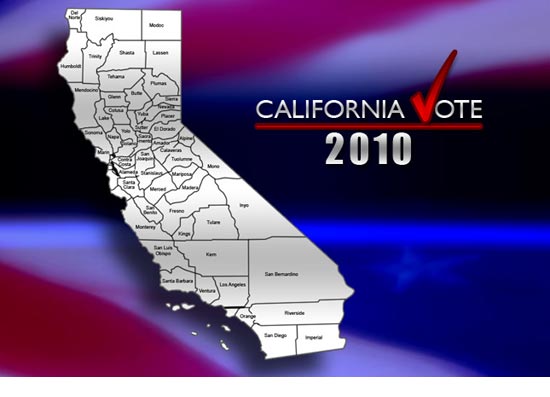






 Check for the latest closure information
Check for the latest closure information








